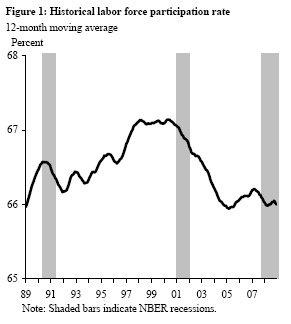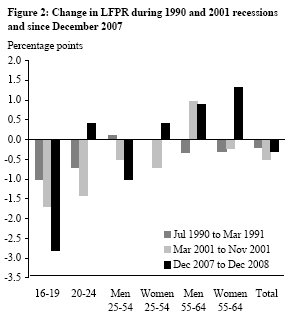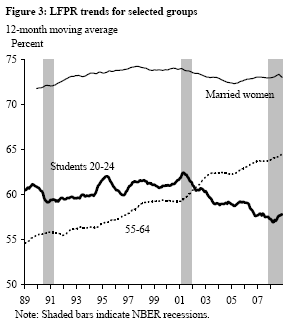Recent declines in house prices and the stock market have led to the most substantial contraction in household wealth since the Great Depression. From the third quarter of 2007 through the third quarter of 2008, household wealth shrank by $6.7 trillion (Federal Reserve Board of Governors 2008).
- Labor supply models and aggregate trends
- A closer look at labor supply behavior by group
- Looking ahead
- References
Recent declines in house prices and the stock market have led to the most substantial contraction in household wealth since the Great Depression. From the third quarter of 2007 through the third quarter of 2008, household wealth shrank by $6.7 trillion (Federal Reserve Board of Governors 2008). Further declines in financial markets and house prices in the fourth quarter undoubtedly made losses for the full year 2008 even greater. At the same time, the severe disruptions in financial markets have made credit unavailable or too expensive for many households. Indeed, the third quarter of 2008 was the first time in the postwar period that household borrowing was negative. The combination of wealth declines and increased liquidity constraints is having a profound effect on household and aggregate consumption. In this Economic Letter we examine how it may also be affecting household and aggregate labor supply. Using monthly data from the Household Survey of the Current Employment Situation Report, we find evidence suggestive that sharply reduced wealth and liquidity are prompting certain demographic groups to enter the labor force in greater numbers.
Labor supply models and aggregate trends
The standard economic model of labor supply suggests that each individual experiences a trade-off between consumption and leisure, both of which are desirable goods. Individuals fund consumption through income received from working in the labor market or from flows from assets such as housing and financial investments. These flows can come from current returns on investments, loans against accumulated principal (for example, home equity loans), or from loans against expected returns (such as student loans). Individuals can also borrow to fund consumption today and pay debts back later with interest (e.g., credit cards). When deciding to take a job or search for work), individuals consider the state of the labor market, the value they place on leisure, and their ability to fund consumption through flows from wealth and borrowing.
 When the labor market is weak but asset values are high and credit is available, individuals may decide to withdraw from the labor market and invest in school or enjoy leisure, a pattern that characterized the previous two U.S. recessions in the early 1990s and in 2001. Figure 1 plots the 12-month moving average of the U.S. labor force participation rate (LFPR) over the past two decades, defined as the percentage of the civilian non-institutionalized population 16 or older that is working or actively looking for work. The recessions of the early 1990s and 2001 were both relatively modest by historical standards. And, while stock markets were hit hard in 2000, neither recession saw the combination of substantial declines in financial markets and house prices accompanied by severe tightening of credit conditions for average households. Indeed, the 2001 recession was accompanied by large increases in housing wealth. Consumption growth remained remarkably strong over the entire economic decline. With other means to fund consumption, labor force participation fell over both of these periods as individuals returned to school, focused on home production, or enjoyed time away from work.
When the labor market is weak but asset values are high and credit is available, individuals may decide to withdraw from the labor market and invest in school or enjoy leisure, a pattern that characterized the previous two U.S. recessions in the early 1990s and in 2001. Figure 1 plots the 12-month moving average of the U.S. labor force participation rate (LFPR) over the past two decades, defined as the percentage of the civilian non-institutionalized population 16 or older that is working or actively looking for work. The recessions of the early 1990s and 2001 were both relatively modest by historical standards. And, while stock markets were hit hard in 2000, neither recession saw the combination of substantial declines in financial markets and house prices accompanied by severe tightening of credit conditions for average households. Indeed, the 2001 recession was accompanied by large increases in housing wealth. Consumption growth remained remarkably strong over the entire economic decline. With other means to fund consumption, labor force participation fell over both of these periods as individuals returned to school, focused on home production, or enjoyed time away from work.
By contrast, in the current downturn, the decline in housing wealth and credit availability is nearly unprecedented. Since the downturn began, housing values have fallen by 6.8% by one measure and households’ financial wealth has declined by 8.5% (Federal Reserve Board of Governors 2008. In addition, a significant fraction of Americans appears to be unable to access credit card lines or acquire mortgages or student loans at affordable rates (Dash 2008, Shiskin 2008). Labor supply theory suggests that this contraction of household income from sources other than work would result either in severe reductions in consumption or substantial changes in labor supply, or, more likely, some combination of both. Moreover, reduced access to credit means many households must generate labor income rather than borrow to finance current consumption.
Indeed, we have seen steep declines in consumption in recent months. At the same time though, the LFPR has been holding up relative to past downturns and even rising for some groups, despite notable difficulties in the labor market. Data on job losses suggest that the decline in labor market opportunities has been as large as the deep recessions of the early 1980s. Still, the aggregate LFPR has not fallen as in previous recessions. In spite of declining labor market opportunities, more people actually are deciding to pursue them. This apparent effect of lost wealth and access to credit on households’ labor supply decisions is much less often emphasized than the effect on consumption. This is a missed opportunity since, unlike data on consumption, for which only monthly aggregates are released, monthly labor market data are available for different groups of households.
A closer look at labor supply behavior by group
We use monthly data to look more closely at the labor market decisions of population subgroups that might be especially sensitive to recent wealth declines and reduced access to credit. First, we break the population into six age and age/gender subgroups and plot changes in LFPRs for the current and previous two recessions.
 As Figure 2 shows, there is considerable variation across subgroups underlying the aggregate trend in Figure 1. For example, teenagers and men aged 25-54 have been withdrawing from the labor force at the same pace or faster than in the previous two recessions. The key drivers of the anomalous pattern of LFPR are young people 20-24, women 25-54, and workers 55 and older. These groups have either increased their participation during this period or, in the case of the 20-24 group, have not withdrawn to the same extent as in the previous two recessions.
As Figure 2 shows, there is considerable variation across subgroups underlying the aggregate trend in Figure 1. For example, teenagers and men aged 25-54 have been withdrawing from the labor force at the same pace or faster than in the previous two recessions. The key drivers of the anomalous pattern of LFPR are young people 20-24, women 25-54, and workers 55 and older. These groups have either increased their participation during this period or, in the case of the 20-24 group, have not withdrawn to the same extent as in the previous two recessions.
Labor force participation rates of these groups may be more robust during the current downturn than in the previous downturns for several reasons. First, the decrease in the supply of credit to students and the decline in housing and financial wealth of their parents likely put pressure on young people to take jobs to pay for their studies. Second, the hit to household balance sheets as well as the rapid deterioration in employment opportunities for males stemming from declines in construction and manufacturing likely prompted other household members to enter the labor market. Finally, the abnormally large declines in housing equity and financial wealth could delay retirement dates for older workers, increasing their participation rates relative to previous downturns.
For more evidence, we look at the recent behavior of students aged 20-24, married women, and workers aged 55 to 64.
 College-age students. Figure 2 shows that during the past two recessions, the LFPR of young adults dropped considerably, by 1.3 percentage points on average. Such declines were driven by a fall in the LFPR of students, many of whom decided to focus exclusively on school as job prospects worsened (Figure 3). Since June 2008, however, more than 20 banks have suspended their student loan programs and the $260 billion market for student loan asset-backed securities has come to a virtual standstill. The decrease in the supply of credit to students and the fall in housing and financial wealth of their parents have led to a much smaller decrease in the LFPR of young adults (0.1%) and, more notably, a substantial increase in the labor force participation of students (0.5%).
College-age students. Figure 2 shows that during the past two recessions, the LFPR of young adults dropped considerably, by 1.3 percentage points on average. Such declines were driven by a fall in the LFPR of students, many of whom decided to focus exclusively on school as job prospects worsened (Figure 3). Since June 2008, however, more than 20 banks have suspended their student loan programs and the $260 billion market for student loan asset-backed securities has come to a virtual standstill. The decrease in the supply of credit to students and the fall in housing and financial wealth of their parents have led to a much smaller decrease in the LFPR of young adults (0.1%) and, more notably, a substantial increase in the labor force participation of students (0.5%).
Married women 25-54. In the 2001 recession, the LFPR of prime-age women fell significantly, by 0.8 percentage point. Relative to prime-age men, women were more likely to exit the labor market as economic conditions worsened. During the current downturn, however, the gender trends reversed. The LFPR of prime-age women increased by 0.3 percentage point, while that of prime-age men decreased by 0.6 percentage point. This appears to be driven by the behavior of married women, who have been increasing their participation in the labor force since around 2005, when the pace of home price appreciation first started to slow. Surprisingly, this trend has continued in spite of the severe decline in the job market. (Figure 3). Additional household members may enter the labor force during a downturn to increase the savings and wealth of households, and perhaps to assist in funding education.
Workers aged 55 and older. Finally, the abnormally large declines in housing equity and financial wealth may have boosted the LFPR of older workers by delaying their retirement dates. While the LFPR of older workers has been rising for some time, the degree to which older workers participate in the labor market is strongly and negatively correlated with asset returns generally and stock market performance specifically, especially since 2000. By contrast, the LFPR change of younger workers is weakly and positively correlated with such returns. The sensitivity of older workers to stock market performance is not surprising given the shift over the past 15 years from employer-run defined benefit plans to employee-managed defined contribution plans. As the reliance of retirees and near retirees on returns from investments has risen, so has the sensitivity of their labor market behavior to changes in stock market wealth. As in the 2001 recession, the LFPR of those 55-64 increased by more than 1 percentage point, coinciding with an almost 40% drop in stock prices over the past year.
The data suggest that recent shocks to wealth and the rollback of household credit are affecting the labor supply of individuals. Should these changes persist, the countercyclical inflow of workers into the labor market could cause unemployment rates to exceed forecasts, since many entrants into the workforce might be unable to find jobs. We expect that these anomalous labor force participation patterns will persist until the underlying drivers, including depressed asset prices and impaired access to consumer credit, return to normal. Unfortunately, making stronger connections between recent developments and the LFPR is difficult because of such factors as noisy data on LFPR for specific cohorts and the effects of other factors on LFPR, such as the Temporary Extended Unemployment Compensation. Ongoing research, including drawing upon a variety of other data sets, could help clarify our results.
Mary Daly
Vice President
Bart Hobijn
Research Advisor
Joyce Kwok
Research Associate
Federal Reserve Board of Governors. 2008. “Flow of Funds Accounts of the United States.”
Dash, Eric. 2008. “Banks Trimming Limits for Many on Credit Cards.” New York Times, June 21.
Shiskin, Philip. 2008. “Painful Choices as College Bills Wallop Families.” Wall Street Journal, December 11.
Opinions expressed in FRBSF Economic Letter do not necessarily reflect the views of the management of the Federal Reserve Bank of San Francisco or of the Board of Governors of the Federal Reserve System. This publication is edited by Anita Todd and Karen Barnes. Permission to reprint portions of articles or whole articles must be obtained in writing. Please send editorial comments and requests for reprint permission to research.library@sf.frb.org
